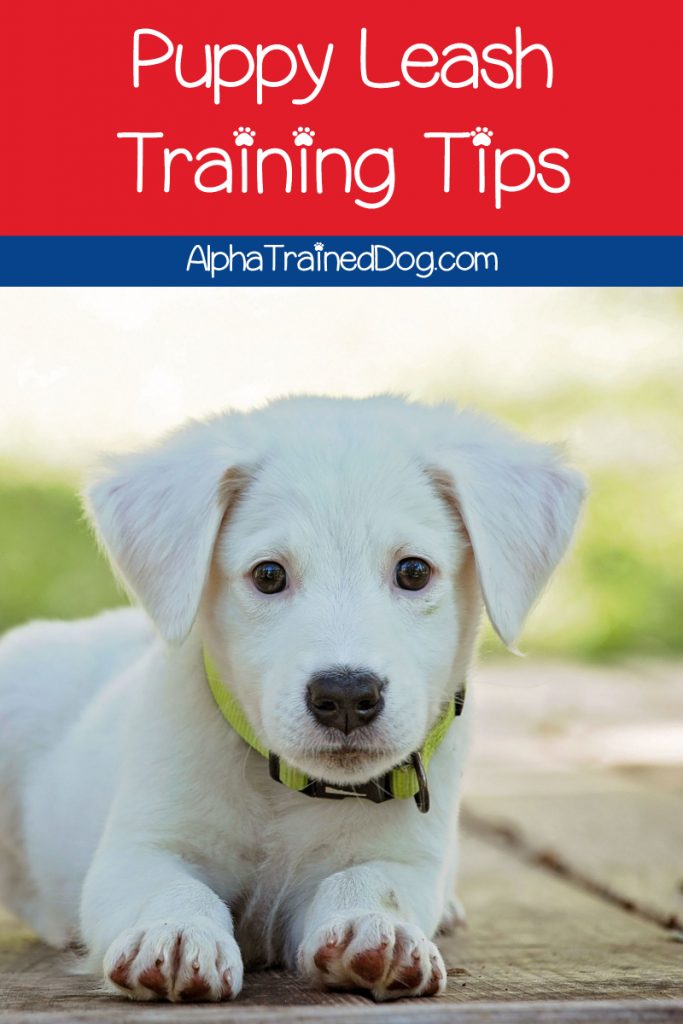Do you need puppy leash training tips on how to teach your dog to walk nicely without dragging you all over the place?
Well, then I’ve got your back!
Below, we’ll check out 7 steps that will have your pooch strolling along next to you nicely in no time!
Just keep on reading.
You may also love: The Complete Lowdown on Dog Clicker Training

7 Puppy Leash Training Steps
Owners sometimes think that their puppy will know how to walk on a leash instinctively.
As such, they are disappointed when the puppy won’t walk on a leash or starts pulling them in the opposite direction.
The truth is that no dog is born knowing how to behave when on a leash. That’s something you must teach.
If you’re lucky, your puppy will get used to the collar and the leash quickly.
But it’s still a process, and it will take time, even when you follow these seven leash training steps.
#1 Pick the Right Collar and Leash
What do you need to leash train your puppy? A collar and a leash, of course.
It’s an obvious requirement, but according to Cesar Millan’s leash training tips, owners often overlook it.
So, first, you need to pick the best leash for training a puppy to walk on a lead beside you.
While you can find a variety of leashes and collars on the market, you don’t need anything fancy. A flat collar and a light leash are perfect for training a puppy.
You can always upgrade later to harness or martingale collar if your puppy proves to be a strong puller.
In addition to purchasing a collar and a leash, you should get high-value treats.
You’re going to need them to create a positive connection in your dog’s mind between the leash/collar and the delicious food.
#2 Start Early
What age should I start leash training my puppy? That’s something a lot of dog owners ask about because they can’t tell if the puppy is ready for the leash.
Here’s my advice. Puppies are fast learners, and the sooner you start leash training, the easier it will be for you.
Most specialists agree that around 2 months is the best puppy leash training age.
Start leash training inside in a room with no distractions when the puppy is in a good mood.
Keep the sessions short, and don’t forget to reward and praise.
#3 Introduce the Collar Slowly
Don’t be surprised if your pooch freaks out about the collar. Dogs don’t like the feel of something around their necks and might try to chew it off.
To prevent such situations, you should put the collar when your puppy is distracted.
For example, try it during mealtimes or when you’re playing in the yard. Keep rewarding with treats as long as your pooch is tolerating the collar.
Let the little one wear the collar for a short time and then remove it. Continue practicing until your puppy doesn’t mind the collar and actually looks forward to it.
Don’t scold or punish your puppy, but remember to use positive reinforcement. The goal is to make your pooch associate the collar with good things, and stressing your pet is counterproductive.
Don’t forget to ensure that the collar is not too tight to chafe the skin. Check out the video below for tips.
#4 Introduce the Leash
Once your puppy is comfortable with the collar, it’s time for the lead.
First, attach the leash collar and let your puppy run around the house with the leash dragging behind. Just keep an eye to make sure that the leash doesn’t get tangled into something.
If you have another dog, let the two of them play together while the leash is still attached. If not, you should play some games with the puppy and engage in some obedience training.
From time to time, pick the leash and ask the puppy to come to you. Don’t yank or use force. What you’re doing is letting your puppy get comfortable with the feeling of the leash.
#5 Encourage the Puppy to Follow You
By now, your puppy should be used to the collar and the leash. That’s great.
But now comes the hard part of how to train your dog to walk on a leash beside you:
- Don’t yank the lead or force the puppy to come to you.
- Instead, gently pick up the lead and call the puppy to your side. Use treats as a bribe if the little one doesn’t respond to the command.
- Put a treat in your hand and keep the hand at your puppy’s head level.
- Start walking slowly. The puppy should follow enticed by the reward.
- If the puppy stops and refuses to move, walk a few steps, drop to one kneel, and call your pet to come to you.
- Keep practicing.
You can also watch this video to see another way to teach your puppy to walk on a leash:
#6 Prevent Leash Pulling
When your puppy starts to enjoy walks outsides, your pet will start pulling the lead. That’s because your puppy has smelt something interesting, or he’s not satisfied with your slow pace.
While pulling might seem innocent at the beginning, you have to stop this behavior right away. Otherwise, the puppy grows into a dog who pulls his leash and drags you around.
One of the strategies that work when you have to teach a puppy to walk on a leash without pulling is to stop moving. If you let your puppy drag you forward, you’re rewarding the behavior, so the puppy will repeat it.
You can also try going in the opposite direction to show the puppy that you’re in charge, and you decide the route.
In addition to this, you have to reward the puppy when he walks calmly beside you. Whenever the lead gets tight, you should stop the food so that the puppy will learn how to behave.
#7 Deal with Leash Biting
Besides pulling, another common problem during leash training is a puppy that bites the leash. In your puppy’s mind, leash biting is a form of tug-of-war, and dogs enjoy a few things more than playing tug.
So, if you tug on the leash, you’re rewarding your puppy’s behavior and making it more likely to repeat.
Instead, you have to redirect the tugging to acceptable chew toys and reward your pooch whenever he behaves on the leash.
In addition to this, sometimes puppies bite the leash due to frustration.
That means that you have moved too quickly through the steps, and your pooch needs more time to get used to the lead.
The tips in the video below will help you deal with leash biting.
It sounds easy when you read about it, but puppy leash training requires a lot of patience, commitment, and consistency.
Keep your calm, and never let your frustration get the better of you.


Trackbacks/Pingbacks